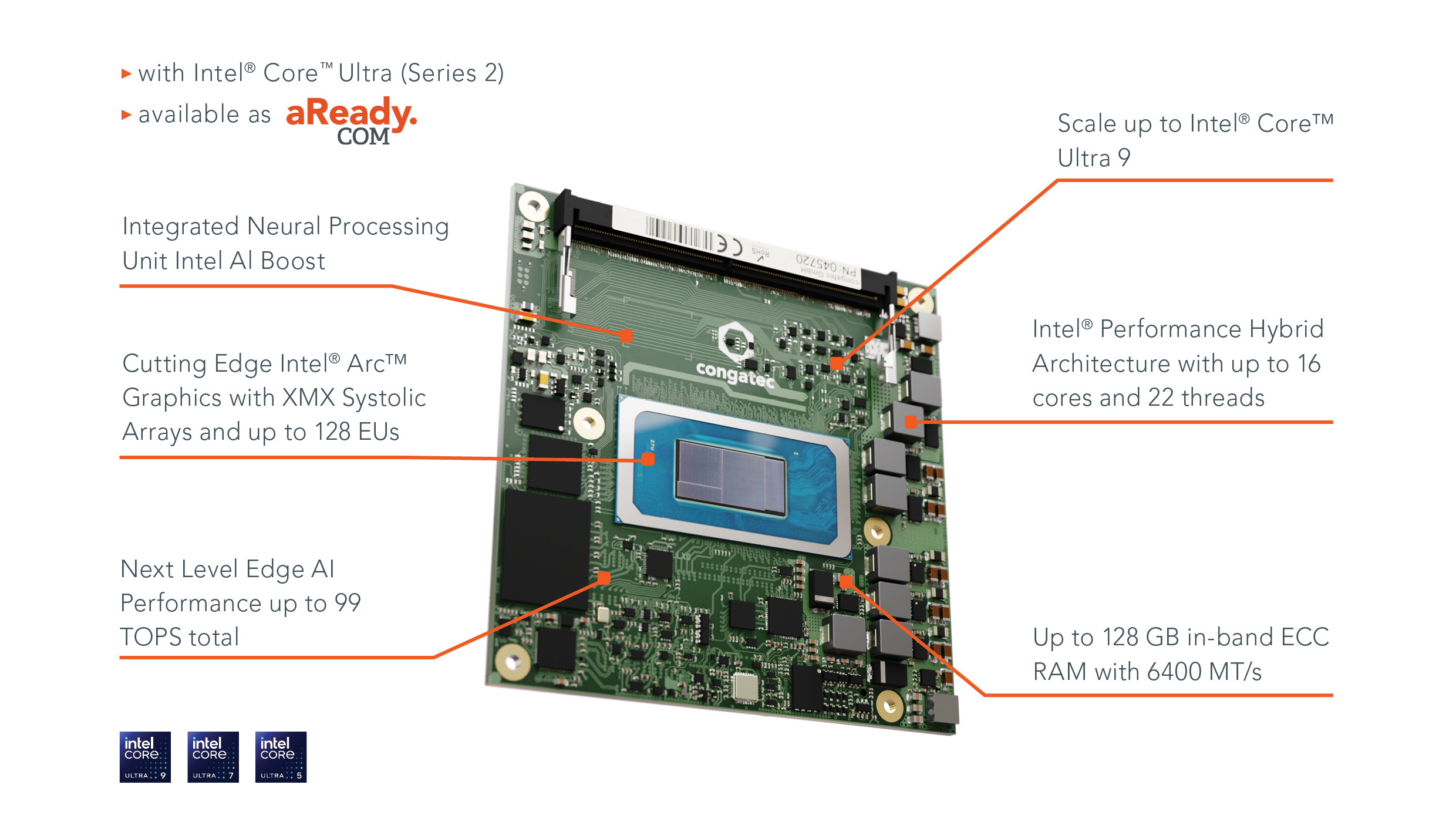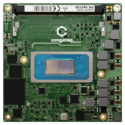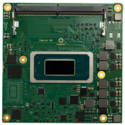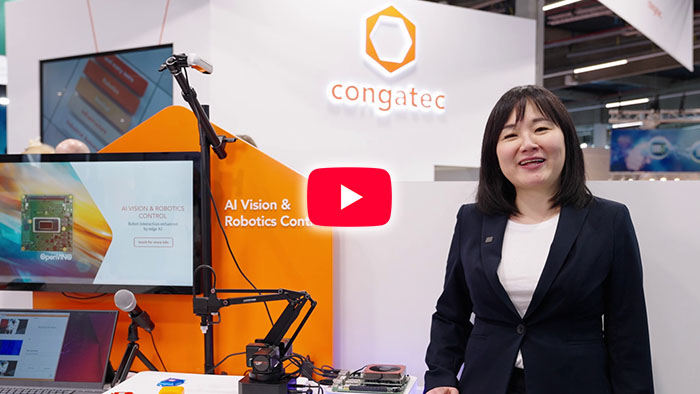
COM Express with
Intel Core Ultra Processors
New dimensions for
high-performance edge computing designs
COM Express Computer-on-Modules with Intel Core Ultra Series 1 and 2 processors
New dimensions for the improvement of established high-performance edge computing designs
The COM Express standard, the most widely used standard for the modular design of dedicated embedded and edge computing systems, now provides new dimensions to improve the performance and power efficiency of well-established OEM designs with Intel® Core™ Ultra Series 2 processors codenamed Arrow Lake, and Intel® Core™ Ultra Processors codenamed Meteor Lake.
The key advancements include:
- A hybrid system on chip (SoC) architecture that combines multiple tiles (also known as chiplets) in a 3D manufacturing process
- A GPU that achieves performance levels comparable to discrete graphics cards.
- The integration of a neural processing unit (NPU), and
- Process technologies as small as 3 nm for extraordinary performance and power efficiency

Facts, Features and Benefits of Intel Core Ultra based modules
| Feature | Improvement | Benefits |
|---|---|---|
| COM Express 3.1 Computer-on-Modules | Compared to COM Express 3.0, PCI Gen4, USB 4, MIPI CSI and SoundWire are now supported, as well as signal integrity and loss budget information for SATA Gen 3. | Support for the latest interface and processor technologies opens up new performance dimensions for existing OEM designs and the opportunity to secure their return on investment in NRE costs in the long term. |
| Improved manufacturing process | Up to 24 % improved CPU performance per watt compared to predecessor. | Existing designs can run more efficiently at the same workloads, saving energy costs and increasing sustainability or more performance at a given power consumption to increase application productivity. |
| Integrated AI accelerator | Integrated NPU accelerator to boost AI inference at the edge. | The integrated NPU accelerator executes machine learning algorithms and AI inferences approximately 20 times more power efficiently compared to instruction sets of x86 CPUs. |
| Faster GPU | Intel Arc graphics with up to 8 Xe Cores and up to 128 EUs for up to 4x 8K displays. | The graphics performance reaches the level of discrete GPUs, resulting in an even 1.9 times faster graphics and/or GPGPU processing for a more detailed, significant and immersive user experience. |
Real-time support, powerful AI, and stunning graphics
COM Express 3.1 Computer-on-Modules with Intel® Core™ Ultra Series 2 processors and Intel® Core™ Ultra Processors are perfect candidates for real-time applications that improve their operation with situational awareness and anomaly detection.
The integration of high-performance real-time computing, powerful AI capabilities, and stunning graphics processors in COM Express 3.1 compliant Computer-on-Modules using Intel® Core™ Ultra Series 2 processors and Intel® Core™ Ultra processors offers significant advantages for vision-based situational awareness, and automated object and anomaly detection in real-time applications. Moreover, these enhancements are available within a low power consumption range, making them suitable for mobile and battery/solar-powered real-time edge computing systems.
Medical systems
AI in medical imaging swiftly identifies anomalies and promptly communicates them to medical professionals, expediting the diagnostic process. Real-time control is essential for surgical robots to ensure seamless and precise operations.
Defect detection
AI enhances real-time defect detection by instantly identifying anomalies, surpassing standard image data processing limitations that can only detect pre-defined defects.
Autonomous mobile robots
Vision and AI-based situational awareness combined with real-time control significantly enhance the performance of autonomous mobile robots (AMRs) and collaborative robots (COBOTs) by improving their operational capabilities.
Autonomous guided vehicles
Autonomous guided vehicles (AGVs) benefit greatly from AI algorithms that enable decision-making and navigation, enhancing their efficiency and effectiveness in various industrial applications.
Humanoid robots
AI empowers humanoid robots to actively listen to individuals, analyze their facial expressions and gestures, and comprehend their desires and requirements. Real-time control capabilities are particularly crucial for seamless collaboration between human and robotic counterparts.
Energy and EV-charging infrastructure
AI algorithms are essential for balancing distributed energy generation and consumption in smart grids, ensuring efficient and effective grid management.
Image processing AI applications away from hard real-time requirements
COM Express modules based on the Intel® Core™ Ultra Series 2 processors and Intel® Core™ Ultra processors excel not only in real-time applications but also in a wide range of embedded and edge computing scenarios. These modules leverage the SoC’s integrated AI capabilities and powerful graphics, making them ideal for various applications that require advanced processing and graphics performance.
Laboratory analyzers
AI can significantly expedite the process of obtaining knowledge about the composition of blood and other fluids. By leveraging machine learning algorithms, AI can analyze vast amounts of data and identify patterns that may not be readily discernible to human experts.
Self-checkout systems
Vision-based self-checkout systems can greatly benefit from AI algorithms trained on a wide range of products. By leveraging AI, these systems can accurately and efficiently identify various items without the need for manual input or barcode scanning.
Smart Signage
By leveraging AI algorithms, smart signage can analyze customer demographics, weather conditions, and traffic patterns, making it more intelligent, adaptable, and capable of delivering targeted messages to the right audience at the right time.
Modules based on the Intel® Core™ Ultra Series 2 Processors and Intel® Core™ Ultra Processors make any equipment smarter
The Integrated AI of COM Express modules based on the Intel® Core™ Ultra Series 2 processors and Intel® Core™ Ultra Processors can bring significant benefits to embedded and edge computing systems, even if they are not explicitly designed for AI-centric applications. By leveraging AI capabilities, these systems can enhance their performance, efficiency, and functionality across a wide range of use cases.
Virtual assistance
By integrating AI-supported virtual assistance functions, the user-friendliness of Human-Machine Interfaces (HMIs) can be significantly enhanced. These virtual assistants can provide intuitive and context-aware guidance to users, helping them navigate complex interfaces and perform tasks more efficiently.
Stunning video
AI algorithms can be leveraged to enhance image quality by reducing noise, improving sharpness, and enhancing details. These algorithms utilize deep learning techniques to analyze and understand the content of an image, allowing for intelligent adjustments that result in improved visual clarity and fidelity.
Intrusion detection
By integrating AI for intrusion detection, cyber-attacks can be effectively identified through anomaly detection techniques, enhancing the overall security posture of the system.
Check out our Computer-on-Modules
based on the Intel® Core™ Ultra processors (Series 2) and Intel® Core™ Ultra processors
Further relevant media
EXPERT VIDEO
High-performance AI for robotics
Claire Liu demonstrates the powerful AI capabilities of congatec’s COM Express Module in a real-life demo together with Intel. This demonstration highlights efficient edge AI processing using the conga-TC700 COM Express Type 6 module based on Intel Core™ Ultra processors. See demanding AI applications like natural language processing, image segmentation, and object recognition in action.
EXPERT VIDEO
Workload consolidation in action
Timo Kühn demonstrates a key capability for modern embedded systems to streamline development of demanding automation applications: workload consolidation.
EXPERT VIDEO
CoMs for AI in a nutshell
Maximilian Gerstl takes you on a quick and intensive tour and gives you a clear overview of congatec’s AI-accelerating modules
- perfect for powering your next automation application.
The reality of AI for medical applications
Discover how AI is transforming medical diagnostics with real-world applications powered by cutting-edge embedded computing.
Decoding AI Hardware Performance: Usable Metrics Beyond TOPs
Uncover why TOPS don’t tell the full story on AI hardware and discover the metrics that really matter for real-world inference performance.






